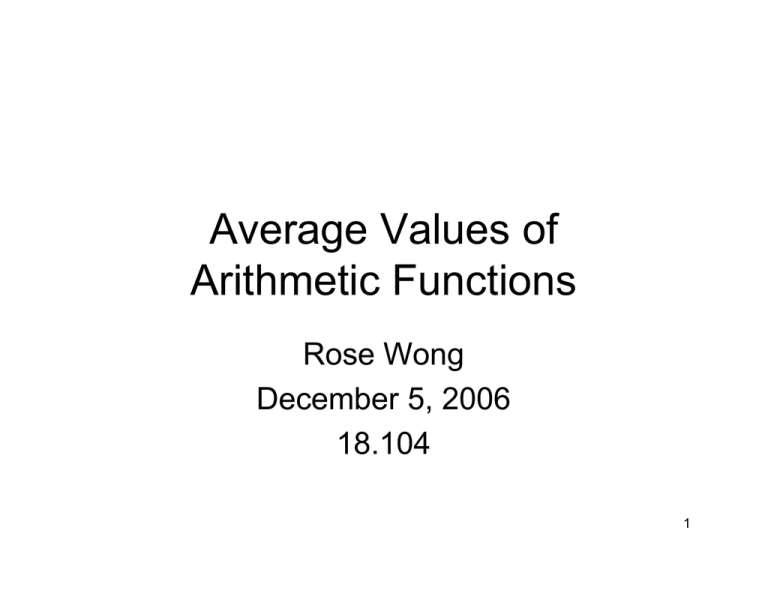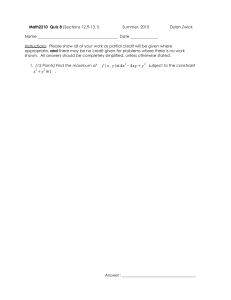Average Values of Arithmetic Functions Rose Wong December 5, 2006
advertisement

Average Values of Arithmetic Functions Rose Wong December 5, 2006 18.104 1 Outline 1. Introduction 2. Average number of representations of n as a sum of two squares 3. Average number of representations of n as a sum of three squares 4. Average number of primitive Pythagorean triangles with hypotenuse n 5. Average number of divisors of n 2 Introduction • Recall: Arithmetic Functions f ( n) : Ν → C • Examples: Π (x) d (n) » Number of primes less than or equal to x » Number of divisors of n • The average of an arithmetic function is defined to be: f (1)+ ... + f (n) , n = 1,2,3,... n • In particular, we want to look at the average as nÆ ∞ . f (1)+ ... + f (n) lim n →∞ n 3 Outline 1. Introduction 2. Average number of representations of n as a sum of two squares 3. Average number of representations of n as a sum of three squares 4. Average number of primitive Pythagorean triangles with hypotenuse n 5. Average number of divisors of n 4 Average number of representations of n as a sum of two squares • Let r(n) be the number of representations 2 2 n = x + y such that • Theorem: The average number of representations of a natural number as a sum of two squares is π . That is r (1)+ ... + r (n) =π lim n →∞ n 5 Average number of representations of n as a sum of two squares (continued) • • • Proof R (n) = r (1)+ ... + r ( n) Let and r(n) be the number of lattice points with integer coordinates on the circle x2 + y2 = n R(n) = r (1)+ ... + r (n) Hence, 1+R(n) is the number of lattice points inside the 2 2 circle x + y ≤ n Idea- Place a unit square on each lattice point inside the circle and count the number of squares to find the area. 6 Average number of representations of n as a sum of two squares (continued) • • • • The total area of unit squares is 1+R(n) ⎛ 1 ⎞ Upper bound of area is π ⎜⎜⎝ n + 2 ⎟⎟⎠ Lower bound of area is π ⎛⎜⎜ n − 1 ⎞⎟⎟ 2⎠ ⎝ 2 2 So, ⎛ ⎛ 1 ⎞ 1 ⎞ 2 2 π ⎜⎜ n − ⎝ • ⎟⎟ < 1 + R (n) < π ⎜⎜ n + 2⎠ ⎝ Using fact that π 2 <5 and that πn − 6 n < R (n) < πn + 6 n 0< π 2 ⎟⎟ 2⎠ −1< n n = 1,2,3... R(n) − πn < 6 n R ( n) 6 −π < n n R ( n) →π • Taking limit as nÆ ∞ , we have n 7 Outline 1. Introduction 2. Average number of representations of n as a sum of two squares 3. Average number of representations of n as a sum of three squares 4. Average number of primitive Pythagorean triangles with hypotenuse n 5. Average number of divisors of n 8 Average number of representations of n as a sum of three squares • Let f(n) be the number of representations 2 2 2 n = x + y + z such that • Theorem: The average number of representations of a natural number as a 4 sum of three squares is 3 π .That is f (1)+ ... + f (n) 4 lim = π n →∞ n 3 9 Average number of representations of n as a sum of three squares (continued) Proof • Let • F ( n) = f (1)+ ... + f ( n) Let f(n) be the number of lattice points with integer coordinates on the sphere 2 2 2 x + y +z =n • Hence, 1+F(n) is the number of lattice points inside the sphere x2 + y2 + z2 ≤ n • Idea- Place a unit cube on each lattice point inside the sphere and count the number of cubes to find the volume. To estimate volume, we find volume of an outer sphere that encloses all cubes and an inner sphere that is inscribed inside the cubes. 10 Average number of representations of n as a sum of three squares (continued) • • • The total area of unit cubes is Radius of outer sphere is Radius of inner sphere is • Comparing volumes, we get • Using fact that 2 3π < 11 and that 3 π < 3 , and rearranging, 2 we get • Dividing by n 3/ 2 • Taking limit as nÆ ∞, we have 1 + F ( n) 3 2 3 n− 2 n+ 3 4 ⎛ 3⎞ 4 ⎛ 3⎞ ⎟ < 1 + R ( n) < π ⎜ n + ⎟ π ⎜⎜ n − ⎟ ⎜ 3 ⎝ 2 ⎠ 3 ⎝ 2 ⎟⎠ 3 4 R(n) − πn 3 / 2 − 3π n + 1 < 11n − 3 3 R (n) 4 3π 1 11 3 − π − + < − 3/ 2 n n3/ 2 n3/ 2 3 n n R ( n) 4 → π 3/ 2 3 n 11 Outline 1. Introduction 2. Average number of representations of n as a sum of two squares 3. Average number of representations of n as a sum of three squares 4. Average number of primitive Pythagorean triangles with hypotenuse n 5. Average number of divisors of n 12 Average number of primitive Pythagorean triangles with hypotenuse n • Let P(n) be the number of primitive Pythagorean triangles with hypotenuse equal to n. 3 5 10 6 4 Primitive 8 Not Primitive • Example: P(5)=1 and P(65)=2 32 + 4 2 = 52 33 2 + 56 2 = 63 2 + 16 2 = 65 2 • We want to look at: P(1)+ ... + P(n) =K n →∞ n lim 13 Average number of primitive Pythagorean triangles with hypotenuse n (continued) • • We want to examine the average of P(n) for large values of n. Approach (computer): For each value of n from 1 to 1000, we generate the average values and plot them on a graph. We want to look at the behavior as n grows large. Plot of P(1)+ ... + P(n) n vs n 14 Average number of primitive Pythagorean triangles with hypotenuse n (continued) • From the figure, we see that the average values (measured on the vertical axis) oscillate, but that the average levels level off quickly. • We can conjecture that P (1)+ ... + P(n) lim ≈ 0.159 n →∞ n 15 Outline 1. Introduction 2. Average number of representations of n as a sum of two squares 3. Average number of representations of n as a sum of three squares 4. Average number of primitive Pythagorean triangles with hypotenuse n 5. Average number of divisors of n 16 Average number of divisors • Let d(n) be the number of divisors of the natural number n. • Example: d(8)=4 • Theorem: The average value of the number of divisors of natural numbers grows like log n. d (1)+ ... + d (n) ~ log n n 17 Average number of divisors (continued) Proof • Let k be a fixed integer. Listing multiples of k less than or equal to n, we have ⎡n⎤ k ,2k ,3k ,...⎢ ⎥ k ⎣k ⎦ • ⎡n⎤ There are ⎢⎣ k ⎥⎦ multiples, where [ ] denotes the floor function. Each of these multiples contributes 1 to the sum d (1) + ... + d ( n) • Examining multiples of all integers k≤n ⎡n⎤ ∑ ⎢ k ⎥ = d (1) + ... + d ( n) k =1 ⎣ ⎦ n 18 Average number of divisors (continued) ⎡n⎤ ∑ ⎢ ⎥ d (1) + ... + d (n) k =1 ⎣ k ⎦ lim = lim =1 n →∞ n → ∞ n log n n log n n • Now, we want to prove that • First we establish the relationship: • Summing over k gives: n ⎡n⎤ n −1< ⎢ ⎥ < k ⎣k ⎦ k ⎛ n ⎞ n ⎡n⎤ n n ⎜ − 1⎟ < ∑ ⎢ ⎥ < ∑ ∑ ⎠ k =1 ⎣ k ⎦ k =1 k k =1 ⎝ k n n 1 ⎛ 1 1 ⎞ n ⎡n⎤ n∑ ⎜ − ⎟ < ∑ ⎢ ⎥ < n∑ n ⎠ k =1 ⎣ k ⎦ k =1 ⎝ k k =1 k n • Factoring out n gives • The first and last term are rewritten in integral form n n⎛ 1 n⎛ 1 ⎞ 1⎞ ⎡n⎤ n ∫ ⎜ − ⎟dk < ∑ ⎢ ⎥ < n ∫ ⎜ ⎟dk 1 1 ⎝k n⎠ ⎝k⎠ k =1 ⎣ k ⎦ 19 Average number of divisors (continued) Integrating gives ⎡n⎤ n log n − n + 1 < ∑ ⎢ ⎥ < n log n k =1 ⎣ k ⎦ • So taking nÆ∞ , we have ⎡n⎤ ∑ ⎢ ⎥ k =1 ⎣ k ⎦ lim =1 n → ∞ n log n • And so, d (1)+ ... + d (n) ~ log n n n • n 20


